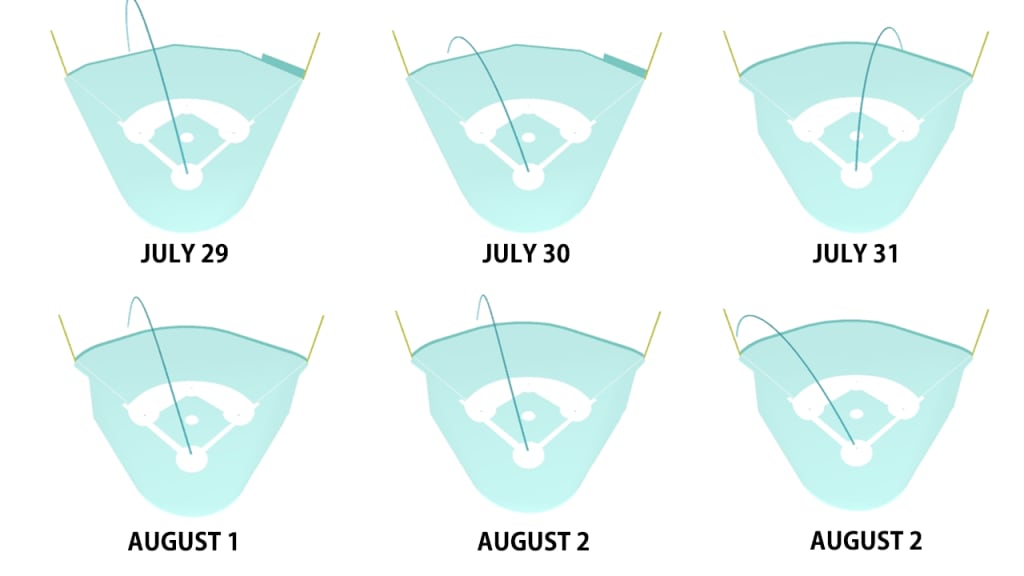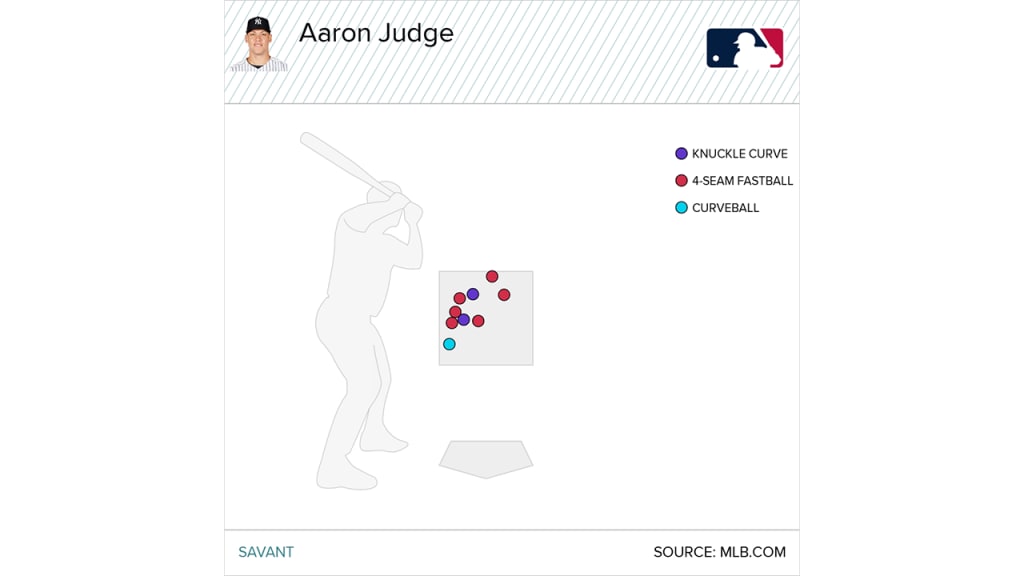Aaron Judge exists in Major League Baseball to mercilessly punish baseballs, and he's doing exactly that. The Yankee right fielder has a homer in five consecutive games -- six total in that span -- leaving him three short of tying the Major League record of eight consecutive games with a homer held by, among others, former Yankee legend Don Mattingly.
This is, to be absolutely clear, a hot streak, one that cannot be sustained, because it's been five games of this, and just eight on the season. It is not possible for anyone to hit a home run every single night for an entire season, even if that season is only 60 nights. Yet it's been so impressive, especially from a man who didn't even start swinging a bat until June due to a rib injury, that it's worth at least taking a look into. Obviously, we're talking about a week's worth of games here. The Yankees have played three teams, and just one series at home. It's not enough, but it's what we've got.
So, what's standing out so far?
1) He's whiffing more and hitting the ball hard less often.
Wait. What?
Well, it's true. Might as well start with the shock value, just because it's counter-intuitive. You might have thought this kind of run would have meant more contact and more power, especially with monster blasts like this one:
It hasn't! His hard-hit rate is down from last year's 58.4% to this year's 55%; his swing-and-miss rate is up from last year's 14.5% to this year's 17.4%.
We're obviously splitting hairs here; a hard-hit rate of 55% is still Top 20 in the game, among those with 10 batted balls. It is extremely good. But he's striking out in nearly one-third of his plate appearances, and he always hits the ball hard. Whatever's behind his streak, this isn't it.
2) He's pulling the ball more.
It seems so long ago now, but for much of the last season, there was a ton of discussion about how Judge simply wasn't pulling the ball. This chart below, showing where his outs went, is from August 17, 2019; he didn't pull his first home run until August 20.
That changed a little late in the year -- he pulled six homers in August and September -- but overall, he pulled only 24% of his fly balls and line drives. This year, that's nearly three quarters (8 of 11), and as you can see, he's already got nearly as many home runs hit to left (five) in the last week as he did in all of 2019 (six).

The pull power is back. Now: Does that matter? Maybe, if it's an indication of improvements in his health or technique or timing, as Mark DeRosa explained on MLB Network on Monday morning.
"When you're hurting, and your oblique is damaged or your wrist is damaged, and you see that short porch in right, he doesn't want to create that torque and everything that goes along with pulling the baseball, so he was just shooting the ball the other way."
As an indicator of health, it's wonderful, and that matters. As a path in and of itself to success, it might not. As MLB.com's Andrew Simon wrote last summer ...
"When Judge directs the ball toward center or right field this year, he’s still one of the most dangerous hitters in the game."
... and that's true. Dating back to 2017, Judge has the highest opposite field slugging percentage of any right-handed hitter. Pulling the ball, for most hitters, leads to higher exit velocities and shorter distances to the fence. But in Judge's case, he smashes the ball no matter where it is. It's notable, but more for the underlying reasons than the direction of the ball itself. (It might, at least, make people stop talking about the short right-field porch in the Bronx. This isn't Didi Gregorius we're talking about.)
Speaking of which:
3) He's healthy.
“He's healthy, man,” said first baseman Luke Voit. Well, OK.
"When he got that clean bill of health and right before summer camp started, he started ramping up," manager Aaron Boone said. "There's just been an intensity level to his work, an energy level to the work that he's been able to do."
It's worth noting here that Judge has taken 502 plate appearances -- i.e., qualified for the batting average title -- just once, back in 2017. His rookie season in '16 ended early due to an oblique injury. In '18, he fractured his wrist after being hit by a pitch. Last year, he missed two months with another oblique injury.
Then, as baseball endured the interminable shutdown all spring, his status was a mystery, thanks to injuries to his rib, lung and neck. As recently as July 1 -- just barely more than a month ago -- this is what general manager Brian Cashman had to say:
“We're very optimistic as of right now that maybe his proclamation that he would be ready Opening Day and in the lineup will ring true. He has been essentially doing all of his physical activities. Now it comes down to game reps, facing live pitching and seeing if he's in game shape. I think there is optimism that if everything works out in the next three weeks, he'll respond really well to that Spring Training 2.0 and he has a shot to be plug-and-play and ready to go.”
Maybe the layoff did Judge some good. After all, had the season began in March like it was supposed to, recovering players like Judge might have pushed harder to be ready in time rather than being able to recover.
4) He's making better swing decisions.
"Right now, it’s just about not missing my pitch," Judge said. "When there’s times when they leave one over the plate, I’ve got to do some damage on it. Fortunately enough, I’ve been able to do that a couple of times early on."
He's not wrong. He's got nine hits, and look at where they were located.

It's that idea of "not missing my pitch" that's interesting, because in the early going, his swing choices have been different. Judge is swinging a little more -- 48%, up from 42% last year -- but a lot less on the first pitch -- down to 50%, from 61% last year.
That's because on the first pitch, hurlers are terrified to attack him. Just look at his rate of first-pitch fastballs over the last few years:
2016: 31%
2017: 28%
2018: 30%
2019: 27%
2020: 19%
He's swinging more in the zone, but -- and this is important -- missing more outside it, and that's a good thing, at least when it's before two strikes. Before two strikes, Judge has missed on 60% of his swings outside the zone. In previous years, that's been 37%. Why could that be good?
Think about it this way: Even the mighty Judge is better when putting swings on good pitches. For his career, he's got an 82.2 MPH velocity on balls outside the zone before two strikes ... and 97.7 MPH inside it.
For example, just before he pounded an Asher Wojciechowski 1-2 pitch for a homer on July 29, he did this:
And just before he crushed a 2-2 curve from Zack Godley on Saturday, he did this:
Those are bad results ... that led to very good ones. It's not a strategy to miss, obviously. It doesn't predict he'll do this all year. But it's better to live to fight another day than make bad contact.
5) He's feasting on below-average pitching.
Here are the six pitchers who have allowed homers to Judge so far this season.
• Matt Barnes
• Zack Godley
• Matt Hall
• Cole Sulser
• Ryan Weber
• Asher Wojciechowski
Barnes, to his credit, has been a high-quality reliever for several years, and he just left a hanging curveball over the plate to a dangerous hitter.
As for the rest? Godley (July 13) and Hall (January 13) were each cut loose by the Tigers earlier this year before landing with Boston. Weber has made two starts and hasn't yet collected a strikeout. Combined, they have a 5.19 career ERA.
6) Maybe it's because he's had runners on base.
This is what Judge attributes it to, anyway.
"It's been helping me a lot having DJ [LeMahieu] in front of me, getting three hits a night and always on base, always causing a little havoc," Judge said on Friday. "I'm just trying to feed off that."
There's always talk about "lineup protection," the idea that a strong hitter behind you will force the pitcher to give you better pitches to hit. (This idea has been proven to be false in numerous studies, and the premise doesn't really make sense if you dig into it.) But a far more compelling idea is that the hitter ahead of you is more important, in that the pitcher will act differently with a runner on.
Then again, for as well as Judge hits with runners on base (career .948 OPS), he's hit slightly better with no one on base (.967). Two of this year's six homers have come with the bases empty. He's seen about 45% of his pitches this year with a runner on base, which is more or less the same as he sees every year. He's actually seeing fewer fastballs with runners on than he usually does.
So, it's probably not this. Then again, if he thinks it is, well, we can't quantify confidence.
7) He's a great hitter on a good hot streak.
Right. Since 2017, there's only been one hitter better than Judge, and that guy is maybe going down as the best player who ever lived: Mike Trout.
Judge, obviously, is not going to keep hitting like this. Absolutely no one can. But it shouldn't be a huge surprise that a healthy Judge is mashing baseballs, either. It's what he's here to do.

